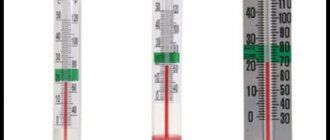- What should a dog's normal body temperature be?
- Methods for measuring body temperature in dogs. How to do it right?
- What to do if your dog's body temperature is different from normal?
The value of body temperature in dogs is a very important indicator that indicates the general condition of the animal, the presence or absence of inflammatory processes, intoxication, as well as shock and poisoning in its body. It is this physiological value that helps the dog owner to objectively assess whether his pet is sick and determine whether he needs emergency veterinary care. The normal body temperature of a dog is 37.5-39.00C and is a very individual indicator, which depends on a huge number of factors, both from the animal itself and its external environment. Therefore, every breeder should know what indicators of this parameter are typical for his pet, periodically measuring his dog’s temperature in a quiet and comfortable environment.
Normal body temperature in a dog
Scientists have found that the concept of “normal body temperature” is not a single stable indicator that cannot be changed. In fact, this is an interval that allows the animal’s body to maintain an optimal level of metabolism and vital activity.
The normal temperature for a dog is a value between 37.5 and 39.50C.
The upper and lower limits of the norm should cause alarm in the owner and become a reason for a careful examination of the pet.
What temperature and pulse should a dog have normally?
Every responsible owner knows what a dog's normal temperature is. This indicator depends on factors such as the age and size of the animal.
In addition, it is important to take into account the dog’s genetic data.
Attention! Sometimes, due to breed characteristics, slight hyperthermia can be the norm (this occurs in large, furry dogs of advanced age)
Dependence of average temperature on dog size
| Size | Index |
| Small breeds (Yorkshire terrier, Jack Russell, etc.) | 38.5-39 °C |
| Medium breeds (Labrador, German Shepherd, etc.) | 37.4-38.3 °C |
| Large breeds (Alabai, Great Dane, etc.) | 37.5-39 °C |
| Small breed puppies | 38.5-39.2 °C |
| Medium breed puppies | 38.2-39 °C |
| Large breed puppies | 38.3-39.1 °C |
The table shows the average values. Minor deviations up or down are allowed (up to +- 0.5 °C in normal condition, in older dogs or bitches after birth - up to 2 °C).
It is also important to know what the heart rate (heart rate) is in a healthy dog. When measuring the pulse, it is worth taking into account the emotional state of the dog. For example, during play the animal is excited, causing the heart rate to increase. In this case, the measurement of heart rate indicators will be biased.
For small breed dogs such as Spitz, Chihuahua, Yorkie, Jack or Dachshund, pressure in the range of 100-130 beats per minute is considered normal. Medium breeds such as Husky or Rottweiler should have a heart rate of 70-140. In large breeds the figure is the same.
Important! In puppies (especially in the first month), the temperature is very dependent on external conditions, so they need to be constantly monitored.
Even a small deviation can lead to serious problems.
How to take a dog's temperature
To find out how your pet is feeling and whether it is worth sounding the alarm, you need to measure its body temperature. Currently, there is only one correct method, which experts have been practicing for several decades.
You can take measurements yourself, without the help of outsiders. And every owner should know how to do this correctly, so as not to cause unpleasant associations and a stressful situation for the animal.
To perform the manipulation you will need a few simple items:
- Medical gloves;
- Medical or veterinary thermometer;
- Vaseline or fatty cream.
The whole procedure takes a little time, but it should be performed carefully and carefully. Lubricate the tip of the thermometer generously with greasy cream or Vaseline. Calm your pet, pet it or talk to the animal. Lifting the tail, carefully insert the tip of the thermometer 2-3 cm into the dog's anus. Perform the manipulation slowly. If the animal squeezes the sphincter, then stop and do not try to force the thermometer inside. This can damage the rectal mucosa. There is also a danger of breaking the tip of the thermometer and causing serious injury to your pet from broken glass.
The duration of the measurement ranges from 30 seconds to 5-7 minutes depending on the type of thermometer used.
Based on the result obtained, the owner or veterinarian makes a conclusion about the condition of the animal and the need to take any measures.
Main symptoms
Many owners believe that the first sign of a fever is a dry nose. It would be wrong to rely on this symptom, since an animal’s nose can be dry and hot, for example, immediately after waking up from sleep.
Here are more sure signs of a rise in temperature:
- weakness, apathy, decreased physical activity;
- lack of appetite;
- increased thirst;
- chills;
- diarrhea, vomiting (in some cases);
- convulsions;
- light tongue and lips;
- the desire to get comfortable in a cool place, on the floor;
- redness of the skin (partial).
Another common mistake among inexperienced dog breeders is to consider any increase in temperature, even a slight one, as a signal for action. During the day it can fluctuate within one degree, and this is also considered normal. However, if in addition to hyperthermia there are other signs, then a visit to the veterinary clinic should not be postponed.
Symptoms of fever in a dog
There is an opinion among owners that the main symptom of an increase in temperature is a hot and dry nose of the animal.
Veterinarians identify several main signs that may indicate an increase in body temperature:
- The appearance of white streaks or scabs on the tip of the nose;
- Increased body temperature in the groin or armpits;
- Palpation (palpation) of regional lymph nodes will determine their size and will be an indirect sign of a bacterial or viral infection, which is accompanied by an increase in body temperature;
- Change in gum shade. They may be unusually red or whitish, swollen or edematous;
Increased skin temperature in the area of the ears and paws. These areas of the body are supplied with a large number of blood vessels, so during hyperthermia they will be hot.
Veterinarians note that there are secondary signs indicating an increase in body temperature in an animal:
- Refusal to eat;
- Lethargy and decreased activity;
- The appearance of a dull shade of fur;
- Disorder of the gastrointestinal tract;
- Difficulty urinating (dark urine and infrequent urge);
- Mucus discharge from the eyes or nasal cavity;
- Spasms
If a dog has an elevated body temperature, then it tries to avoid communication with other animals or people. The dog looks for secluded places, trying to choose shaded areas with a minimum amount of sunlight. If possible, choose areas of cool flooring (concrete base, ceramic tiles, etc.).
What to do if the temperature is high or low
Changes in indicators, a decrease or increase in the dog’s temperature, should alert the owner. If there are accompanying symptoms: the animal refuses food and treats, it has diarrhea or vomiting, general weakness, then this may be a sign of illness. The pet needs to be taken to a doctor, consulted, tested and started on the prescribed treatment.
You can call a veterinarian to your home or take your pet yourself.
Here's what to consider if you're taking a sick animal to the doctor:
- If your pet's temperature is high: 40°C or higher, you need to apply a bottle or ice pack to her body, especially in hot weather;
- If the readings are below 36.5°C, then place a heating pad next to the animal to avoid hypothermia; you can turn on the heating in your car or open the windows in the heat.
As for how to bring down a dog’s temperature or raise it, it’s worth noting. You should not give any medications on your own before taking them, especially if you are expecting your pet to give birth. Only a specialist, a veterinarian, can make a correct diagnosis after examination. He will give treatment according to it, and any medications taken before the appointment will distort the test results.
A high temperature, over 40°C, or a drop in temperature in an animal of any breed can be caused by diseases such as plague, piroplasmosis, infection with worms, endothermite, allergies. Any trauma can raise it: extensive cuts, inflammation in bites from other dogs, abscesses. Some increase may be observed after vaccinations.
Reasons that can cause an increase in temperature
There may be several reasons for an increase in body temperature in an animal. It is important to understand that the temperature indicator is a balance between the process of heat generation and heat transfer. That is, the balance of biochemical and physical processes. An imbalance leads to hyperthermia or hypothermia.
Let's look at the main reasons that can cause an increase in body temperature in a pet:
Inability to release heat to the environment. A classic example is heatstroke, in which the animal overheats and the ambient temperature is much higher than body temperature. In this case, the body accumulates a huge amount of heat, which it cannot release as a result of cooling, because the air is much hotter.
Negative effects of pyrogens. Pyrogens are substances that trigger active biochemical reactions accompanied by the release of large amounts of heat. Pyrogens include parts of bacterial cells, as well as toxins formed as a result of intoxication, decay of tumors, etc.
Allergic reactions can also cause the development of hyperthermia. An allergen entering an animal’s body triggers a complex biochemical process. The result is an increase in body temperature.
Stress. Strong emotional stress can cause a sharp drop in temperature or lead to short-term hyperthermia. It all depends on the type of the dog’s nervous system, as well as on its physical condition.
It is important! High temperature negatively affects the condition of the animal. But with a bacterial infection, it also has a positive effect on the course of the disease. Thus, the rate of division of bacterial cells is significantly higher than that of ordinary cells. When the temperature rises, the normal development cycle of the bacterial cell is disrupted and the disease recedes.
What to do when an animal has a fever?
It is best to use either a rectal or a universal thermometer.
To clearly understand why this characteristic of a dog’s body can be increased, you need to understand the basic rules of the animal’s heat exchange.
Under normal conditions, the dog receives the necessary amount of heat, which must be released into the external environment. When, for some reason, the amount of heat removed is less than the heat received, an increase in temperature can be observed in the animal.
If we are talking about diseases, then along with an increase in the animal’s body you can observe the following symptoms:
- loss of appetite;
- weakness and lethargy;
- diarrhea;
- vomiting or retching;
- decreased physical activity;
- convulsions;
- hair loss.
Any combination of the above is definitely a trip to the vet. Remember, the earlier the disease is diagnosed, the less dire the consequences of the disease will be for your pet, and in some cases, for your family members.
Endometritis and similar diseases can significantly increase a dog’s body temperature. Heatstroke can also cause fever. A low temperature can be caused by parvovirus enteritis, mainly in young animals, or by worms.
What is the normal temperature for dogs? The veterinarian knows, and in these cases it is the veterinarian who must diagnose your dog's illness and prescribe the appropriate treatment. Often self-medication can lead to fatal consequences due to incorrect diagnosis of the disease.
If an animal needs to be taken to a veterinary hospital, then during transportation you need to remember:
- If the dog’s body index is above 40 degrees, then the animal should be disturbed less. If possible, place an ice bag on the animal.
- If the value is too low, then the animal should be wrapped and a heating pad placed on the body.
Emergency methods to reduce fever
To bring down the temperature a little and make the animal feel better, before starting a large-scale fight against the disease, you should resort to the following actions:
- ventilate the room;
- cool the room by 2-3 degrees;
- close the windows with curtains to prevent the room from warming up from the sun's rays;
- wet the cloth in cool water and place it on the dog’s stomach;
- Place a bowl of cold water next to the animal and change it as the water warms up.
You should resort to medication only if the dog’s body is already warmer than 40.5 degrees.
It is known that normal temperature in dogs is the key to proper development and physical activity. It is its indicators that indicate the health and well-being of the animal as a whole. It does not have constant indicators; it is individual for each breed. If in the human body body temperature is regulated by sweating, then dogs cannot sweat, since only some breeds have sweat glands, the rest cool their body by breathing frequently and sticking their tongue out.
Normal temperatures in dogs can vary throughout the day, especially as they age. Significant deviations in one direction or another indicate the presence of some kind of disease.
For a healthy animal, the normal temperature should be 37.5°–39.3°.
The indicator may vary depending on the physiology, age of the dog, the environment where it is located and the breed.
In addition to size and age, a slight increase in temperature (0.5–1.5 ° C) may occur in hot weather. The animal is looking for a cool place, breathing frequently. Large dog breeds have a particularly hard time withstanding heat.
Emotions play a very important role for dogs; for example, when they are frightened, in an aggressive state or overexcited, the temperature can jump. This is normal physiology and you should not be afraid of it.
Important! If the temperature deviates significantly from the norm, especially in the presence of other clearly observable symptoms of the disease, the animal should be immediately shown to a veterinarian.
A certain dependence of the temperature of dogs on breed, age and size was revealed. For example, in small dogs it is slightly higher than in adults. This happens due to metabolic processes in the body - in puppies they pass faster, therefore, the puppy’s body is much warmer in comparison with an adult dog. Moreover, the heart rate of puppies is also higher and ranges from 60 to 120 beats/min. If the normal temperature in a healthy dog is 37.5° and higher (up to 38.5°C), then in puppies it is about 1 degree higher.
Below is a table of average body temperatures depending on the age and size of the animal:
But there are individual characteristics that affect the deviation of values from the norm; they exist in every breed and in every specific animal. This is associated, for example, with physical exertion, a state of fear, during childbirth or during the female’s estrus.
Timely treatment and diagnosis are the key to successful recovery from even serious illnesses. That is why monitoring changes in temperature and health is considered the main task of a dog owner if he decides to get one and place it in his home.
Important! If the pet refuses to eat and drink, and the nose has become dry, possibly hot, when other signs of malaise are observed, then the most correct and correct decision is to measure the body temperature.
For these purposes, you can use a conventional medical thermometer: electronic or mercury. This manipulation is not difficult, but still requires careful handling of the dog.
Measurements are made by inserting a thermometer into the rectum (anus):
- First, the thermometer should be completely zeroed and lubricate its tip with Vaseline.
- The animal is laid on its side, the tail rises slightly, slowly and very carefully the measuring device is inserted into the depths of the anus, about 2 cm.
- The dog at this moment must be absolutely calm; excitement or fear are unacceptable, since they can provoke an increase in temperature. Also, if the dog suddenly jumps up, it can injure itself or break the thermometer, so the animal should be secured in a lying position if possible. To calm her down or as a reward, you can give her some goodies.
- Positive emotions have a beneficial effect on the animal, so it should be praised both before and after the procedure.
Measuring the temperature with a mercury thermometer is very inconvenient since it will take at least 5 minutes. It is much easier to measure it electronically - it will show the exact result in just 1 minute.
Therefore, it is more advisable to purchase an electronic thermometer, especially if the pet participates in exhibitions or competitions, because such dogs should have their temperature measured several times a day.
To understand the reasons for the increase in body temperature in a dog, you need to know the main features of heat exchange processes. In a calm state, the animal receives the required amount of heat and must release the same amount of heat into the environment.
When the body receives significantly more than it is capable of releasing, the dog develops a fever, which contributes to disturbances in the functioning of the body and vital processes in it.
Symptoms accompanied by an increase in body temperature in a dog:
- loss of appetite (complete or partial);
- lethargy and weakness;
- gastrointestinal disorder (diarrhea);
- vomiting or frequent urge to vomit;
- complete refusal of normal activity;
- dry nose, sometimes it can be hot;
- the appearance of seizures;
- hair loss.
Remember! A high temperature is only a symptom of some disease, so if it is present, the animal should be diagnosed to identify the disease and prescribe the correct treatment.
Several main reasons for a drop or rise in temperature:
- A significant increase in indicators may indicate the development of piroplasmosis, endometritis (usually in females), when receiving heat stroke, and so on.
- A decrease in value may be evidence of parvovirus enteritis (in young individuals or puppies), the presence of helminthic infestations, and so on.
That is why it is very important to know what the animal’s temperature is. Unfortunately, not every dog breeder understands that low or high temperature is only a symptom, the result of the pet’s body’s struggle, and not the disease itself.
In such a case, consultation with a veterinarian is simply necessary. You can call a specialist to your home or take your pet to the veterinary hospital yourself. During transportation, the following rules should be followed if the temperature:
- above 40° C - the dog should be disturbed less, if possible, put cold on the body (a bag of ice);
- 36.5° C and below - the dog needs to be wrapped up and a warm heating pad applied to the body so that the animal does not become hypothermic.
Regardless of what temperature the dog has (high or low), self-medication is extremely undesirable. If you bring down a high temperature before visiting a veterinary hospital, then there is a possibility that: firstly, you can greatly aggravate both the dog’s condition and the disease itself, and secondly, it will make it difficult to establish the correct diagnosis.
Important! Only after a correct diagnosis in a veterinary clinic, determination of the type of infection, the severity of the disease and the prescription of therapy can one begin drug treatment as prescribed by the veterinarian.
The owner of a sick dog can independently try to bring down the high temperature a little to make the pet feel better, before starting full-scale treatment. These simple steps will help avoid dehydration of the animal’s body at elevated temperatures:
- ventilate the room;
- cool the room by at least 2° C;
- curtain the windows with thick fabric or curtains to protect it from the sun's rays;
- wet a regular cloth in cool water and apply it to the dog’s tummy;
- Place a bowl of cold water next to it, changing it regularly.
Medication methods should be used exclusively in emergency cases, when the temperature is much higher than normal and exceeds 40.5 ° C:
- An injection is considered an effective antipyretic. The injection should consist of: 2 ml of analgin solution, 1 ml of no-shpa in liquid form and 0.5 ml of diphenhydramine. The injection is administered intramuscularly.
- If it is not possible to give an injection, then you can give the dog 0.2 tablets (this is one fifth): analgin, paracetamol, diphenhydramine or suprastin. Any of the above remedies can bring down a high fever. The main thing is not to exceed the dosage, as this is very dangerous for the health of the animal.
- What is the treatment method for puppies? To reduce the fever, the baby should be given children's medications. Products intended for adults are strictly prohibited from being given to puppies.
It is best to use drugs specifically designed for dogs, for example: vedaprofen
(quadrisol) and
carprofen
(rimadyl). These medications are safe for animals, unlike most analogues used in human treatment.
Even if you managed to cope with the fever, you don’t need to calm yourself down; you should definitely show the dog to a veterinarian to find out the reasons for what happened.
Some dog owners, out of inexperience, claim that the normal temperature in dogs is exactly the same as in people, and it is 36.6 degrees. This is not a true statement; although dogs are warm-blooded animals, their indicators are somewhat different. What is a dog’s normal temperature and what does the indicator depend on? Is there a single temperature threshold for all breeds of these animals, or does it vary? All these and many other questions require more careful consideration and professional clarification.
The variety of dog breeds is very large; animals can vary greatly in size, physiology and other factors. Accordingly, their normal temperatures may differ, and quite significantly.
The general norm of 37.5-38.5 will be too general, and therefore it is worth highlighting breed gradations at least according to the size of the animal:
- Small breeds have the highest normal temperature - more than 38.5 degrees. The smallest dogs can have a temperature of 39.3 degrees for puppies and 39 for an adult.
- Medium-sized dogs have a temperature between 37.5 and 39 degrees.
- Large breed animals have a temperature of 37.4 to 38.3 for an adult, and 38.2-39 degrees for a puppy.
In addition to breed and size, the temperature in dogs varies depending on the gender and physical, physiological condition, age, and even the personality of the animal. And therefore it is impossible to give such a clear gradation of its norm as for a person.
How to lower an animal's temperature
Veterinarians remind that attempts to independently select medications to reduce body temperature can lead to a worsening of the situation.
You should not use medications prescribed to a person!
This is due to the fact that the side effects in a pet are much more pronounced. You should also abandon the idea of force-feeding the animal. The food will not be digested properly, and indigestion will not do your dog any good.
Some effective ways to reduce body temperature include:
- Regulation of the indoor microclimate. Ideally, the thermometer reading should be 18-20 C. By ventilating the room or turning on the air conditioner, this is very easy to achieve. Drafts should be avoided and the animal should not be allowed to sit on a cold floor.
- Avoid physical activity. During muscle contractions, the body releases a large amount of heat.
- Provide your pet with access to clean and cool water.
By carefully monitoring the animal's condition, the owner can alleviate its well-being. And if the condition worsens, the best solution would be to consult a veterinarian.
Alarm Signals
Knowing what temperature the dog should have and noticing its deviations, every responsible owner will ask himself whether the dog needs to be taken to the veterinarian and whether it needs medical attention. Temperature variations in themselves cannot be an alarming signal if:
- The dog's behavior has not changed; she remains active and friendly.
- The coat is in good condition, it lies close to the body and has a typical healthy shine.
- The animal's appetite is within normal limits.
But there are also a number of indicators that clearly indicate that the dog needs to be shown to a veterinarian, and as soon as possible:
- Breathing and heart rate are greatly increased, and this does not go away and is not associated with increased activity.
- The dog refuses its usual food, and this lasts more than a day.
- The dog vomits, produces a lot of saliva, and has diarrhea.
- Persistent or intermittent anxiety is noticeable and may be associated with pain.
- There are cramps.
If you have these symptoms, or you, as a sensitive owner, simply notice that something is wrong with your dog, you should contact your veterinarian.
Taking your temperature is something you can do on your own and should not be attempted on your own unless you have veterinary training or extensive experience. There is no need to try to lower the temperature on your own, as you can relieve the symptom, but can you cure the disease that led to its appearance?
An immediate call to your veterinarian's home or a visit to the clinic is the best thing you can do for the animal in this situation. You cannot put off solving the problem until later, because in some cases this can threaten the dog’s death. Reducing the elevated or increasing the low temperature is carried out only during transportation to the clinic - use heating pads, blankets, or ice, cool objects, applying them carefully and for a short time.
Be attentive to your pet, its health and well-being, because a dog cannot say in words what hurts and how it feels.
You can also contact our site's staff veterinarian, who will respond to them as soon as possible in the comment box below.
Body temperature is a very important physiological parameter of a living organism. Normal body temperature in dogs is approximately 37.5 – 39°C. The temperature depends on the breed of the dog, its age and physiological state at the time of measurement.
Puppies and dogs of toy breeds have a higher body temperature compared to adult large dogs (38.5-39.2°C). This difference is associated with an increased intensity of metabolic processes. In this regard, the temperature in dogs is normally higher than in humans.
An increase in temperature of 0.1-0.3°C can be observed in the following situations:
- stress (for example, during a clinic visit)
- during heat
- at high air temperatures (heat, traveling in a car without air conditioning)
- after prolonged physical activity
A pregnant dog's temperature drops
by 0.5-1°C.
Each dog's body temperature is normally individual. It is necessary for the owner to know what indicators of this parameter are typical for his pet. For these purposes, you need to periodically take temperature measurements in a quiet environment at home.
When you urgently need to see a doctor if you have a fever
The need for professional help arises if a dog develops:
- Convulsions;
- Loss of consciousness;
- Discharge of unclear nature;
results exceed 39.5 C. You should not administer medications on your own or try to reduce the fever. A consultation with a veterinarian will help identify the cause of hyperthermia, as well as select an effective course of treatment.
What to do at home
There is no single treatment regimen for hyperthermia, since it is not a separate disease, but a symptom, and it does not always indicate a pathology developing in the dog’s body.
Of course, you need to show the animal to a specialist in any case, but you can provide first aid at home.
In order for the body to begin to give off excess heat, it is necessary to lower the ambient temperature. It is enough to ventilate the room or turn on the air conditioner for a short time. Ideally, the air temperature should not exceed 20 degrees. Drafts are not allowed!
The dog needs to be covered with ice cubes (in the groin, neck, armpit area), covered with a damp towel or slightly moistened the fur, and given an enema with warm water. You should not allow your pet to move a lot, as a lot of thermal energy is generated when the muscles work.
If the animal does not want to eat, you should not force feed it, as problems may increase - diarrhea, constipation, bloating, vomiting. But a warm drink is very useful.
If the temperature is very high, an adult dog weighing 30 kilograms or more can be given one of the antipyretic drugs intended for humans. For small dogs, it is better to use children's medicine to relieve fever.
However, it is better not to take risks, since drugs such as Aspirin, Analgin, Paracetamol can cause side effects in dogs. For example, Ibuprofen is dangerous because it can provoke gastrointestinal bleeding, intense vomiting, etc.
When to measure
Under normal conditions, a slight increase or decrease in temperature in dogs is quite acceptable, especially if the indicator lasts for a short time. For example, fever is possible in very warm weather; the temperature of bitches during estrus rises. Even the emotional state of the animal affects this: excitement or fear also provokes fever. Therefore, the alarm should be sounded only if the deviation from the norm lasts for a long time - more than several hours.
Temperature should be measured if there is a reason for it. This is not a very pleasant process for the animal; one should not abuse its patience. So, it is necessary to monitor this indicator in bitches on the eve of and after childbirth, and monitor changes before and after vaccinations. It is also worth keeping a temperature map during an animal’s illness - measurements in this case are made several times a day.
Be sure to check your temperature if you observe any alarming symptoms: general depression, lethargy, or, conversely, nervousness, signs of pain, and others.
Symptoms
The best way to measure a dog's body temperature is to use a thermometer. If for some reason this is not possible, then pay attention to the visual signs of hypothermia:
- shiver;
- convulsions;
- pallor of the skin and mucous membranes;
- the animal seems cold to the touch;
- the dog is lethargic, constantly sleeps;
- unnatural behavior:
- the animal may hide, be aggressive, or, on the contrary, be too affectionate;
- breathing slows down, heart rate decreases;
- with severe hypothermia, the pupils stop responding to light;
- when the temperature drops critically, coma occurs.
If measures are not taken, complications may develop: acute renal or cardiovascular failure, bronchopneumonia, pancreatitis. Be sure to show your pet to a veterinarian, as without treatment he may die.
What to do?
If body temperature is 39.5-40°C
: carefully examine the dog, remember what has happened to your pet over the past few days. You may be able to determine the cause of the fever or identify some signs of illness. In any case, it is necessary to show the dog to the doctor on the same day.
Significant increase in temperature, above 40-41°C
requires immediate medical attention and emergency care.
Owners need to know:
- An increase in body temperature above 40.5°C leads to loss of fluid from the body, decreased or absent appetite, general depression, accompanied by rapid heartbeat and breathing
- Body temperature above 41.1°C leads to critical loss of fluid from the body, can cause swelling of the brain and serious disturbances in the functioning of internal organs, which are manifested by rapid heartbeat and heart rhythm disturbances, severe shortness of breath, accompanied by wheezing, loss of consciousness, convulsions and impaired coordination of movements, diarrhea and vomiting, yellowing of the conjunctiva of the eyes and the oral mucosa, lack of urine and the appearance of an acetone odor from the mouth, bleeding from the intestines and hemorrhages on the skin. Any of these complications can quickly lead to the death of the animal.
If the temperature rises above 41°C, you should try to bring it down:
It is necessary to put ice on the neck and inner thighs; if this is not possible, wet the dog’s fur with cold water and provide small portions of cool water to drink.
You should not administer antipyretics or give pills at home. Some of these drugs may do more harm than good. It is better to limit yourself to physical cooling methods. It is important to take the animal to the doctor as soon as possible!
Causes of low temperature
Body temperature can drop for many reasons. There are 3 degrees of hypothermia:
- Light (up to 32 degrees)
- Moderate (up to 28 degrees)
- Severe (less than 28 degrees)
If the dog's body temperature is below 36.5 degrees, then it must be taken to a veterinary clinic immediately. Hypothermia can be primary (exposure to cold, immersing the dog in cold water) and secondary (serious injury, extensive blood loss).
The most common causes of low temperature:
- hypothermia of the body in the winter season;
- anesthesia during surgery;
- exhaustion;
- thermoregulation disorder in cases of serious injuries, such as traumatic brain injuries;
- diseases of the thyroid gland, kidneys, liver;
- poisoning.
Also, low body temperature can be observed in small puppies due to the imperfection of their thermoregulation system. For the time when the mother dog has left the babies, they must be placed under an infrared lamp or placed on a heating pad. If this is not done, the puppies begin to crawl in circles, become restless, feel cold, and feel abandoned.
The optimal temperature in the nest for newborns is about 30 degrees Celsius. Short-term hypothermia is not dangerous for puppies, but if the mother or the heating pad that replaces it is not present for a long time, they may die from hypothermia. As the babies grow, the temperature in the nest should gradually decrease. By 3 weeks, puppies begin to have their own thermoregulation system and they no longer need additional heating.
In pregnant bitches, the temperature begins to drop as labor approaches. On average, it drops to 36.9-36.6 degrees, which means that the puppies will be born within 24 hours. After the birth canal opens, the temperature returns to normal and even rises higher. Usually, by the time the last fetus is expelled, it ranges from 39 to 39.5 degrees. Some dogs do not change their temperature before giving birth, so watch closely for other signs as well.
In the last days of pregnancy, be sure to monitor your dog's behavior. Veterinarians advise measuring temperature 2-4 times a day so as not to miss the onset of labor.










